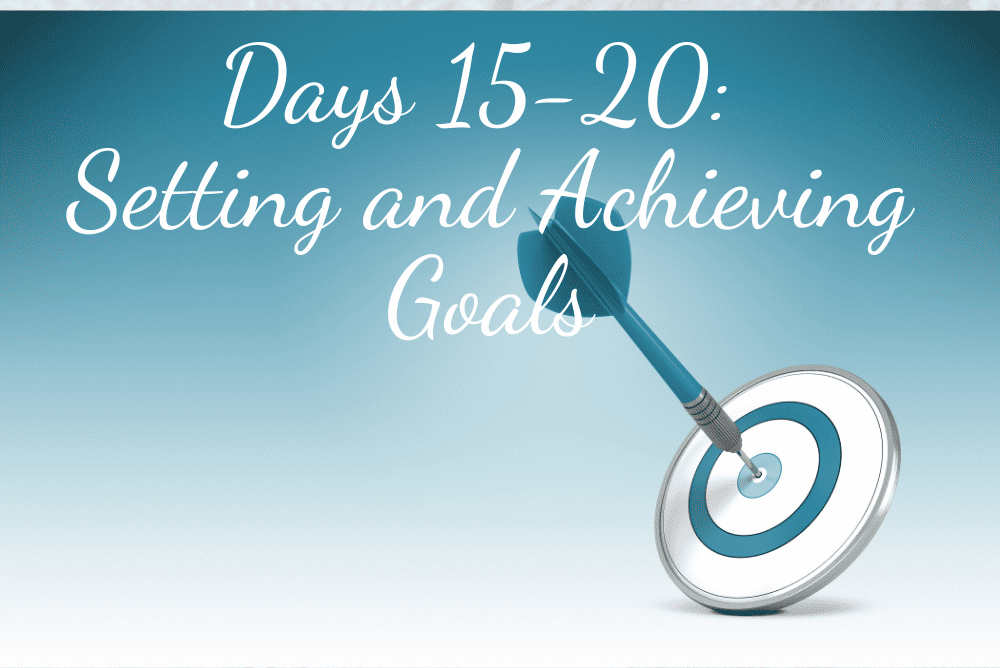Last updated on March 13th, 2023

Welcome to “Rise Above Self-Doubt: A 30-Day Plan to Boost Your Confidence.” This program is for anyone who has ever struggled with self-doubt and felt held back from reaching their full potential.
As someone who has felt the crippling effects of self-doubt firsthand, I know how it can take over your thoughts and stop you from doing things. But I also know that, with the right tools and mindset, it is possible to rise above self-doubt and build confidence.
This 30-day plan is designed to help you do just that. Each day, you will be presented with a new strategy or exercise to help you challenge negative thoughts, build self-compassion, and take action towards your goals. By the end of the program, you will have developed a new mindset and a set of tools to help you continue to build and maintain your confidence.
This plan is not a quick fix, and it will require effort and commitment from you. But I promise that if you follow the plan, you will see a significant shift in your mindset and in your ability to overcome self-doubt.
I believe in you and your ability to rise above self-doubt. Let’s begin this journey together and build the confidence you deserve.
Self-Doubt and Self-Confidence
Self-doubt is a feeling that we’ve all experienced at some point in our lives. It’s that voice in our head that tells us we’re not good enough, we’re not smart enough, or we can’t do it. It’s that feeling that holds us back from taking action and reaching for our goals.
But self-doubt doesn’t just hold us back from achieving our aspirations, it affects our overall well-being, it can make us feel anxious, it can make us second-guess our decisions, and it can make us feel like we’re not worthy of love and belonging.
As someone who has struggled with self-doubt, I understand how it can consume your thoughts and make you feel like you’re stuck in a cycle of negative thinking. But I also know that it is possible to rise above self-doubt and build confidence.
It takes time, effort and consistent work, but with the right mindset and tools, you can learn to silence that negative voice and start to believe in yourself.
It’s time to take the power back and rise above self-doubt. It’s time to reclaim your confidence and start living the life you truly deserve.
30 Day Plan to Boost Your Confidence
The 30-day plan to boost confidence is a complete plan to help you get over self-doubt and become more confident. It is a step-by-step guide that will help you identify and challenge negative thoughts, develop self-compassion, and take action towards your goals.
Each day, you will be presented with a new strategy or exercise that will help you to change your mindset and develop new tools to help you continue to build and maintain your confidence.

Day 1: Identifying Self-Doubt
Self-doubt can manifest in many different ways, and it can look different for everyone. Some common ways that self-doubt can manifest include:
Negative self-talk
This is one of the most common ways that self-doubt can manifest. It’s that voice in our head that tells us we’re not good enough, we’re not smart enough or we can’t do it. It can be critical, harsh and unkind.
Negative self-talk can make you feel like you’re stuck in a cycle of negative thinking, and it can make it hard to believe in yourself and your abilities.
Avoiding new opportunities
This is another common way that self-doubt can manifest. When we doubt ourselves, we may avoid taking risks or trying new things. We may miss out on great opportunities because we’re too scared of failure or rejection. This can hold us back from achieving our goals and living our best life.
Feeling like an imposter
This is another way self-doubt can manifest. It’s a feeling of not belonging, of not being good enough, of being a fraud. It can make you feel like you’re not worthy of success, and that you’ll be exposed as a fraud one day.
Self-doubt can be very powerful and it can be hard to break free from it. But I want you to know that you are not defined by your self-doubt, and you have the power to change your thoughts and beliefs.
With the right mindset, you can learn to silence that negative voice and start to believe in yourself.
You deserve to live a life free from self-doubt, and I believe in you. Let’s work together to rise above self-doubt and build the confidence you deserve.
Exercise to Identify Instance of Self-Doubt in Our Lives
- Keep a journal: Write down instances when you experience self-doubt. This can include negative thoughts you have, situations that trigger self-doubt and how you feel. By writing down your thoughts and feelings, you will be able to identify patterns and see where self-doubt is affecting your life the most.
- Reflect on your self-talk: Notice the way you talk to yourself. Listen to the words you use, and if they are negative, try to change them to positive. When you catch yourself thinking negative thoughts, challenge them, ask yourself if they are true and if not, reframe them.
- Recognize your triggers: Identify situations that trigger self-doubt for you. It could be a specific person, a task, a setting or an event. Once you identify the triggers, you can work on finding ways to manage them better and reduce the impact they have on you.
- Practice mindfulness: Mindfulness can help you to become more aware of your thoughts and feelings in the present moment. By paying attention to your thoughts and feelings, you can learn to recognize when self-doubt is creeping in and take action to challenge it.
- Talk to someone: Sometimes it can be hard to identify instances of self-doubt on our own. Reach out to a trusted friend or therapist and talk about your concerns. They can give you a different perspective and help you see things you might not be able to see on your own.
Journaling to Track Your Progress
Keeping a journal is a powerful tool that can help you to track your progress as you work to overcome self-doubt. Journaling allows you to reflect on your thoughts and feelings, identify patterns and track your progress over time.
When you journal, you can write down your thoughts, feelings, and experiences. You can write about the situations that trigger self-doubt, the negative thoughts you have, and the actions you take to overcome them.
You can also write about your successes, the things you’re proud of and the progress you’re making.
Writing things down can also help you to gain clarity and perspective. When you read your journal later, you can see how far you’ve come and how much you’ve grown.
It can be a powerful reminder of your progress and a source of motivation to keep going.
Journaling is a personal and intimate process, so it’s important to be honest and authentic with yourself.
Don’t worry about making it perfect, just write what comes to mind. And remember that it’s a private journal, it’s for you and your own reflection.
I encourage you to make journaling a regular practice. Take a few minutes each day to reflect on your thoughts, feelings, and experiences. Use your journal to track your progress as you work to overcome self-doubt.
Your journal will be a powerful tool that will help you to see the progress you’re making and to celebrate your successes.
I believe in you and your ability to overcome self-doubt. By keeping a journal and tracking your progress, you will be able to see how far you’ve come and how much you’ve grown.

Day 2-3: Understanding the Root Causes of Self-Doubt
Self-doubt can be caused by a variety of factors, including:
Past experiences
Such as childhood traumas, negative feedback, or past failures, can cause self-doubt. These experiences can shape our beliefs about ourselves and our abilities, making it difficult to believe in ourselves and our abilities.
Societal influences
Such as messages we receive from media and societal expectations, can also contribute to self-doubt. These messages can make us feel like we’re not good enough, and that we’re not measuring up to what’s expected of us.
Unrealistic expectations
Can also cause self-doubt. When we put too much pressure on ourselves to be perfect, to achieve certain goals, or to live up to certain standards, we can feel overwhelmed and doubt our abilities.
Remember that self-doubt is a normal and human experience, and it’s not a reflection of who you are as a person. And it’s also important to recognize that these causes of self-doubt are not permanent, it’s possible to overcome them.
Exercises to explore the underlying causes of self-doubt
- Reflect on your past: Take some time to reflect on your past experiences, both positive and negative. Think about the experiences that have shaped your beliefs about yourself and your abilities. Write down any patterns or themes that you notice.
- Challenge limiting beliefs: Identify any limiting beliefs you have about yourself, such as “I’m not good enough” or “I can’t do it.” Challenge these beliefs by asking yourself if they are true and if not, reframe them.
- Identify societal influences: Think about the messages you receive from the media and society and how they affect your beliefs about yourself. Write down any patterns or themes you notice.
- Examine your expectations: Reflect on the expectations you have for yourself, both realistic and unrealistic. Write down any patterns or themes you notice.
- Talk to someone: Sometimes it can be hard to explore the underlying causes of self-doubt on our own. Reach out to a trusted friend, family member, or therapist and talk about your concerns. They can give you a different perspective and help you see things you might not be able to see on your own.
Continue Journaling and reflect on the insights gained
As you continue to journal, you will be able to see patterns in your thoughts and behaviors, and gain a deeper understanding of the underlying causes of your self-doubt. You will also be able to see the progress you’re making, and the changes in your mindset and attitude.
Reflecting on the insights you gain from journaling is also important. Take the time to read through your journal entries, and consider what you’ve learned about yourself and your self-doubt.
Look for patterns and themes, and think about how you can apply the insights you’ve gained to your life.
Overcoming self-doubt is a journey, and it takes time and effort.

Days 4-7: Challenging Negative Thoughts
Cognitive reframing
Cognitive reframing can be used to challenge negative thoughts and beliefs that hold you back from living your best life.
It involves identifying negative thoughts and beliefs and replacing them with more positive and realistic ones.
It’s a way of taking control of your thoughts and changing the way you see yourself, others, and the world around you, and help you to overcome self-doubt.
We all have negative thoughts and beliefs from time to time, it’s normal. However, when these negative thoughts and beliefs become a pattern, they can hold us back from achieving our goals and living our best life.
Cognitive reframing helps to break this pattern by challenging negative thoughts and beliefs and replacing them with more positive and realistic ones.
The process of cognitive reframing is a gentle and personal process. It’s not about pretending that negative thoughts and beliefs don’t exist, but it’s about acknowledging them, understanding them and then reframe them.
It’s about being kind and compassionate to yourself, it’s about being your own best friend.
Techniques and Exercises to Practise Cognitive Reframing
Here are a few techniques and exercises that you can try to help you practice cognitive reframing:
- Identify negative thoughts: The first step in cognitive reframing is to identify negative thoughts and beliefs. When you notice a negative thought, stop and write it down.
- Challenge the thought: Once you’ve identified a negative thought, challenge it. Ask yourself questions like “Is this thought true?”, “Is there any evidence that supports this thought?” or “What would I tell a friend who had this thought?”.
- Reframe the thought: Once you’ve challenged the thought, reframe it. Replace the negative thought with a more positive and realistic one. For example, instead of “I’m not good enough,” you can reframe the thought to “I am capable and have strengths.”
- Practice mindfulness: Mindfulness can help you to become more aware of your thoughts and feelings in the present moment. By paying attention to your thoughts and feelings, you can learn to recognize when negative thoughts are creeping in and take action to reframe them.
- Repeat the process: Cognitive reframing is a process that takes time and practice. Repeat the process of identifying, challenging and reframing negative thoughts as often as you can.
- Reflect: Reflect on the progress you’ve made and how your thoughts have changed. Take note of the positive effects and how it helps you to overcome self-doubt.
Cognitive reframing takes time and practice. It’s not something that happens overnight, but with consistent effort, you will notice positive changes in your thoughts and beliefs and how it helps you to overcome self-doubt.

Days 8-10: Building a Support System
Having a support system is crucial for overcoming self-doubt. A support system can help provide encouragement, motivation, and accountability, which can help you to stay on track and persevere through challenges.
They can also provide a sounding board for your thoughts and feelings, and offer constructive feedback and advice to help you make progress.
Having a supportive network of people who believe in you and your goals can also help to counteract negative self-talk and provide a source of positive reinforcement.
In addition, sharing your struggles and progress with others can help you to feel less isolated and more connected.
Having a support system can also provide a source of comfort and stability during times of stress and uncertainty, helping you to maintain resilience and optimism.
Moreover, having a support system can help to improve self-esteem and confidence, which can be essential for overcoming self-doubt.
Therefore, it’s important to cultivate a supportive network of friends, family, or a therapist who can help you to face and overcome self-doubt.
Whether through regular check-ins, goal setting, or simply providing encouragement, a support system can help you to stay motivated and achieve your goals.
Action plan to build your own support system
An action plan will help you to be specific about the steps you need to take to build your support system, and it will give you a roadmap to follow as you work towards your goals.
- Identify who you want to include in your support system: This can include friends, family, mentors, support groups, or a therapist.
- Set specific goals: Determine what you want to achieve through building a support system. For example, you may want to find a mentor, reach out to a friend, or join a support group.
- Create a timeline: Set a specific timeline for when you want to achieve your goals. For example, you may want to find a mentor by the end of the month, reach out to a friend within the next week or join a support group by the end of next month.
- Make a plan of action: Break down your goals into small steps and make a plan of action. For example, if you want to find a mentor, you may want to research different mentorship programs, reach out to potential mentors, or create a list of people who may be able to help you in your search.
5. Review and Reflect: Review your progress regularly and reflect on what you’ve achieved and what needs to be improved.
Remember that building a support system takes time and effort, and it’s okay to make adjustments along the way.

Days 11-14: Practising Self-Care
Self-care is an essential part of improving mental and emotional well-being, and it can help boost confidence in a very powerful and loving way.
When you take care of yourself, you are showing yourself that you are valuable and worthy of love and care. When you take care of yourself, you are also setting the foundation for taking care of others and reaching your goals.
Self-care includes taking care of your physical, emotional, and mental well-being.
When you engage in self-care, you are giving yourself the time and space to relax and recharge. This can help reduce stress, improve mood, and increase energy levels.
When you’re feeling good physically and emotionally, you’re more likely to have the energy and confidence to take on new challenges and pursue your goals.
Self-care can also help to improve your self-esteem, and self-worth. When you take care of yourself, you are showing yourself that you are valuable and worthy of love and care.
This can help to boost your confidence and improve your mental and emotional well-being.
Tips for self-care
- Exercise: Engage in physical activity that you enjoy, whether it’s going for a walk, running, cycling, swimming, or dancing. Exercise helps to reduce stress, improve mood, and increase energy levels.
- Healthy eating: Make sure to nourish your body with healthy food. Eating a balanced diet that includes fruits, vegetables, lean proteins, and whole grains can help to improve your physical and emotional well-being.
- Relaxation techniques: Try different relaxation techniques such as deep breathing, meditation, yoga or mindfulness. These techniques can help to reduce stress and improve mood.
- Get enough sleep: Make sure to get enough sleep each night. Aim for at least 7 to 8 hours of sleep per night.
- Connect with loved ones: Connecting with loved ones can help to improve your emotional well-being. Spend time with friends, family, or loved ones that make you feel good.
- Prioritize fun and leisure: Make time for activities and hobbies that you enjoy. Doing things that you enjoy can help to improve your emotional well-being and boost your confidence.
Action plan for incorporating self-care into your daily routine
An action plan will help you to be specific about the steps you need to take to make self-care a part of your daily routine and it will give you a roadmap to follow as you work towards your goals.
Here are a few steps you can take to make an action plan for incorporating self-care into your daily routine:
- Identify what self-care activities you want to incorporate: This can include exercise, healthy eating, relaxation techniques, getting enough sleep, connecting with loved ones, and prioritizing fun and leisure.
- Set specific goals: Determine what you want to achieve through incorporating self-care activities into your daily routine. For example, you may want to exercise for 30 minutes a day, eat a healthy breakfast every morning, or make time for relaxation techniques before bed.
- Create a timeline: Set a specific timeline for when you want to achieve your goals. For example, you may want to exercise for 30 minutes a day starting next week, eat a healthy breakfast every morning starting tomorrow, or make time for relaxation techniques before bed starting from tonight.
- Make a plan of action: Break down your goals into small steps and make a plan of action. For example, if you want to exercise for 30 minutes a day, you may want to research different types of exercise, create a schedule, or create a list of activities that you enjoy.
- Review and Reflect: Review your progress regularly and reflect on what you’ve achieved and what needs to be improved.

Days 15-20: Setting and Achieving Goals
Setting and achieving goals can help to build confidence by providing a sense of accomplishment and progress.
When you set a goal and work towards it, you are taking control of your life and developing a sense of agency and purpose. Accomplishing your goals, no matter how big or small, provides a boost to your self-esteem and can help you to feel more confident and capable.
Setting achievable goals also helps to build confidence by reducing the risk of failure. When you set realistic and attainable goals, you are less likely to experience disappointment or frustration, which can have a negative impact on your confidence.
Instead, setting achievable goals provides a sense of accomplishment and progress, which can help to build your confidence over time.
In addition, setting and achieving goals provides an opportunity to challenge yourself and develop new skills and competencies. This can help to build your confidence by expanding your comfort zone and increasing your sense of mastery and control.
Moreover, goal setting can help to provide a sense of focus and direction. When you have a clear sense of what you want to achieve and the steps you need to take to get there, you are more likely to feel motivated and empowered.
This can help to build your confidence and reduce self-doubt by providing a clear path forward.
Therefore, setting and achieving goals is an effective way to build confidence and reduce self-doubt. By focusing on achievable goals and celebrating small wins, you can build your confidence and feel more empowered and capable over time.
Tips for setting realistic and achievable goals
Setting realistic and achievable goals is an important step in building confidence. One effective way to set goals is to use the SMART framework. SMART is an acronym that stands for Specific, Measurable, Achievable, Relevant, and Time-bound.
Here are a few tips for setting realistic and achievable goals using the SMART framework in a powerful and loving way:
- Specific: Be clear and specific about what you want to achieve. Instead of saying “I want to be more confident”, say “I want to speak up more in meetings” or “I want to take on a new challenge at work”
- Measurable: Make sure your goals can be measured. For example, you can measure your progress by counting the number of times you speak up in meetings or by setting a deadline to complete a new project.
- Achievable: Make sure your goals are realistic and achievable. It’s important to stretch yourself, but you should also be honest about what you can accomplish.
- Relevant: Make sure your goals are relevant to your values and priorities. When your goals align with what you truly care about, you’ll be more motivated to achieve them.
- Time-bound: Set a deadline for achieving your goals. This will give you a sense of urgency and help you stay on track.
Using the SMART framework for setting goals can help you to set goals that are specific, measurable, achievable, relevant, and time-bound. And this will help you to stay focused and motivated as you work towards your goals.
Work towards a goal, and to continue journaling your progress
Journaling your progress is an excellent way to track your progress, reflect on your growth, and keep yourself accountable.
Here are a few tips for setting and working towards a goal and journaling your progress:
- Set a goal: Use the SMART framework to set a specific, measurable, achievable, relevant, and time-bound goal.
- Make a plan: Break your goal into small, manageable steps and make a plan for achieving each step.
- Journal your progress: Keep a journal and track your progress as you work towards your goal. Write down your successes, challenges, and lessons learned.
- Reflect: Take time to reflect on your progress and what you’ve learned. Reflect on how your thoughts and beliefs have changed and how it helps you to build your confidence.
- Celebrate your successes: Take the time to celebrate your successes, no matter how small. Recognize your progress and give yourself credit for the work you’ve done.
- Learn from failures: If you hit a roadblock, don’t give up. Learn from your failures and make adjustments to your plan.

Days 21-25: Facing Fears
Facing and overcoming fears can help to build confidence by providing a sense of mastery and control over our emotions and reactions. When we confront our fears, we are stepping outside of our comfort zone and taking control of our lives.
This can help us to develop a sense of self-assuredness and bravery, which can boost our confidence levels.
Moreover, facing and overcoming fears can help to increase our sense of resilience. When we face and overcome difficult challenges, we are developing the ability to bounce back from setbacks and difficulties.
This can help to build our confidence by increasing our sense of self-efficacy and self-reliance.
In addition, facing and overcoming fears can help increase our sense of personal growth. When we overcome our fears, we are expanding our comfort zone and taking steps towards personal growth and development.
This can help to build our confidence by increasing our sense of mastery and control over our lives.
Facing and overcoming fears can also help reduce the hold that fear has over us. When we face and overcome our fears, we are breaking down the psychological barriers that hold us back.
This can help to build our confidence by increasing our sense of empowerment and control.
Therefore, facing and overcoming fears is an effective way to build confidence and reduce self-doubt.
By taking steps to confront our fears and develop a sense of mastery and control, we can build our confidence and feel more empowered and capable over time.
Identify a fear you want to overcome, and develop a plan for facing it
By taking this step, you are taking control of your life and making a commitment to face your fear head-on.
Here are a few tips for identifying a fear and developing a plan for facing it in a powerful and loving way:
- Identify your fear: Take some time to identify the fear that is holding you back. Be honest with yourself and write it down.
- Challenge your fear: Once you’ve identified your fear, challenge it by asking yourself if it’s rational or not. Often our fears are based on assumptions or past experiences and not necessarily on reality.
- Make a plan: Develop a plan for facing your fear. Break it down into small, manageable steps and set a timeline for achieving each step.
- Use visualization and exposure therapy: Use visualization and exposure therapy techniques to help you face your fear. Start small and gradually work your way up.
- Reflect on your progress: Reflect on the progress you’ve made and how your thoughts have changed. Take note of the positive effects and how it helps you to build your confidence.
- Reward yourself: Reward yourself for facing your fear. Take some time to celebrate your progress and give yourself credit for the work you’ve done.

Days 26-30: Reflecting on Progress and Maintaining Confidence
Prompts to reflect on your progress over the 30 days
- How did I feel on day 1 compared to today?
- What was my biggest accomplishment this week?
- What was my biggest challenge this week and how did I overcome it?
- What did I learn about myself this week?
- What did I do to take care of myself this week?
- How has my mindset changed over the past days?
- What was my proudest moment of this week/month?
- How did I practice self-care this week?
- What was the biggest fear I faced this week and how did I overcome it?
- How have my relationships with others changed over the past days?
- What did I do to improve my self-confidence this week?
- How did I challenge my negative thoughts this week?
- How has my ability to set and achieve goals improved over the past days?
- What was the most important thing I learned this week?
- How did I build my support system this week?
- How did I practice cognitive reframing this week?
- What was the biggest obstacle I faced this week and how did I overcome it?
- How have my feelings towards myself changed over the past days?
- What did I do to overcome my self-doubt this week?
- How did I face and overcome my fears this week?
- How did my journaling help me to reflect on my progress this week?
- How has my ability to set realistic and achievable goals improved over the past days?
- What was my most meaningful accomplishment this week?
- How did I practice self-compassion this week?
- How has my ability to handle stress improved over the past days?
- What did I do to improve my mental and emotional well-being this week?
- How has my overall confidence improved over the past days?
- What will I do to continue building my confidence after the days are over?
- How has my self-perception changed over the past days?
- What will I do to continue facing and overcoming my fears after the days are over?
These prompts are designed to help you reflect on your progress over the past 30 days, and to help you continue to build your confidence, face and overcome your fears and be aware of your feelings and actions towards self-care, self-compassion, and self-improvement.
Maintain confidence and continue to overcome self-doubt
Maintaining confidence and continuing to overcome self-doubt in the long-term requires a combination of different strategies and ongoing effort.
Some key ways to maintain confidence and reduce self-doubt over time include:
- Continual self-reflection and self-awareness: Regularly reflecting on your thoughts, feelings, and behaviors can help you to identify and address any self-doubt that arises. By being mindful of your self-doubt, you can work to challenge negative thoughts and beliefs and maintain your confidence.
- Engaging in self-care: Self-care is crucial for maintaining good mental and emotional health and reducing self-doubt. Incorporating regular exercise, healthy eating, and relaxation techniques into your routine can help you to feel more resilient and confident over time.
- Setting and achieving realistic goals: Setting and achieving goals can help you to build confidence and reduce self-doubt by providing a sense of mastery and control. By setting achievable goals and working towards them, you can develop a sense of self-efficacy and self-reliance.
- Surrounding yourself with supportive people: Having a support system of family and friends can help to provide encouragement, feedback, and support when self-doubt arises. By having a support network, you can feel more confident and resilient in the face of challenges.
- Continuing to face and overcome fears: Facing and overcoming fears is a lifelong process, and continuing to do so can help to build your confidence and reduce self-doubt over time. By taking on new challenges and stepping outside of your comfort zone, you can develop a sense of mastery and control over your life.
- Practicing cognitive reframing: Cognitive reframing is a powerful tool for challenging negative thoughts and beliefs and maintaining confidence. By using this technique regularly, you can continue to reduce self-doubt and build your confidence over time.
Therefore, maintaining confidence and overcoming self-doubt in the long-term requires ongoing effort and a combination of different strategies.
Continuing to journal and reflect on your progress, as well as setting plans for the future in the long-term is an essential part of maintaining confidence and continuing to overcome self-doubt. Journaling helps you to track your progress, reflect on your growth, and keep yourself accountable.
Setting plans for the future allows you to stay focused and motivated and continue your journey towards self-improvement.
Conclusion: A 30 Day Plan to Boost Your Confidence
The key takeaways from this plan include:
- Recognizing self-doubt as a normal part of the human experience and understanding how it can manifest in different ways such as negative self-talk or avoiding new opportunities.
- Building a support system, such as reaching out to friends and family, finding a mentor, or joining a support group can help to overcome self-doubt.
- Practicing self-care, such as exercise, healthy eating, and relaxation techniques, can improve mental and emotional well-being and help to boost confidence.
- Setting and achieving realistic and achievable goals can help to build confidence.
- Facing and overcoming fears can help to build confidence.
- Reflecting on the underlying causes of self-doubt and using cognitive reframing to challenge negative thoughts and beliefs.
- Journaling progress and reflecting on the insights gained to track the progress in overcoming self-doubt and building confidence.
- Maintaining consistency and commitment to personal growth to continue to overcome self-doubt and maintain confidence in the long-term.
I encourage you to continue to work on building and maintaining your confidence. The journey towards self-improvement is ongoing, and it requires consistency and a commitment to personal growth.
You have taken the first step towards self-improvement and you have made progress. Keep going and remember that I am here to support you every step of the way.
I have no doubt that you will continue to rise above self-doubt and build the confidence you deserve.
Keep going, keep growing, and keep rising. You got this!
Embrace the chance to enhance your self-worth, dignity and care. Visit the resources section of Pheelpretty.com and take the first step towards a revitalized and fulfilled life. Join now and transform your mindset with ease!
